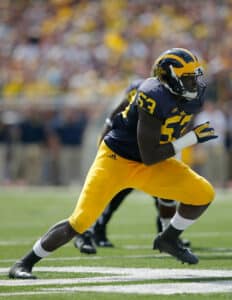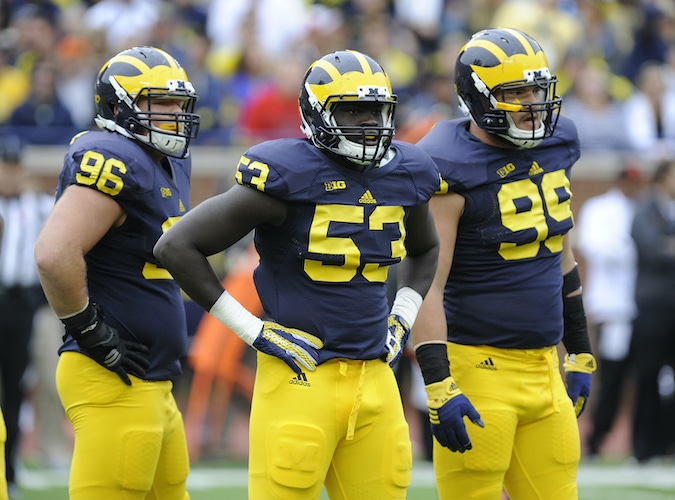DON’T BLAME IT ON RIO: Mario Ojemudia is shown in action in 2015, during his days as a Michigan Wolverine. (Getty Images)
OVG partnerships manager assesses the potential, pitfalls in altered college sports landscape
Mario Ojemudia was headed for a first- or second-round NFL draft pick as a member of the storied University of Michigan Wolverines football team.
Then, the Michigan native ruptured his Achilles tendon.
He eventually made it to the NFL as an undrafted free-agent for the Baltimore Ravens, but the richest rewards for his talent and hard work vanished like a mirage.
“My senior year, I went into the year a (projected) second-round pick in the NFL draft. I could see the dollar signs,” said Ojemudia, now a Chicago-based partnerships manager for VenuesNow parent company Oak View Group.
It was 2016 and agents were hitting him up and with visions of a $10 million contract: life-changing money.

HAIL TO THE VICTORS: Mario Ojemudia in action for the Michigan Wolverines. (Getty Images)
“I was having a great season, the season of my life, but five games in I tear my Achilles,” said Ojemudia, came to OVG after working in partnerships for the Denver Broncos and Atlanta Falcons. “There was no insurance policy. There was no anything.”
In today’s changed college sports landscape, with schools bolting athletic conferences for the greenest broadcast dollar pastures they can find, the new NIL allowances change the game for top athletes in revenue sports, and even some in sports like golf and gymnastics.
It would take an act of Congress for the NCAA to force schools to protect college athletes, or even cover the cost of injury treatment, which can be life-long, Ojemudia says, but for some the NIL system offers a chance to earn some cash before they graduate.
“The marketing dollars, that’s why you’re important to a school,” he said. “They call them student athletes for a reason, because they’re not employees, so they don’t get employee compensation.”
With NIL compensation allowed, some get to establish themselves as businesses before they reach the big leagues, but that doesn’t come without additional effort and attention.
“The brands can now leverage the players in their marketing. When they think about what consumers they want to be in front of, it’s mostly the people that want to interact with the players. It makes for more competition for any type of partnership that exists, whether it be with the universities themselves, the third-party agencies that are going out and selling partnerships, as opposed to going straight to the student athletes and getting deals done there.”
Ojemudia doesn’t see it as a zero-sum game. Dollars going to student athletes don’t necessarily mean venues and the schools are left out.
“Players can now market themselves, as opposed to a brand going to a university and saying hey, we’re gonna pay X amount of money for the whole enchilada, like every single player on the team, basically. That might go straight to the player now, or if they have an agency, through the agency to the player. Is NIL at the expense of the university from a business standpoint? They have to make themselves more competitive, but I think it works in their favor. The marketing towards the player creates another audience that’s going to watch the player. So you are going to watch the player, but you are also going to be watching a university.”
Ojemudia says more total revenue will probably go into college athletics as a result of NIL.
“There’s more dollars that brands are willing to spend by having a player like Caleb Williams as an asset,” he said.
For venues, a full stadium come game time remains as important a part of the equation as ever, not just from the standpoint of ticket, parking, food and beverage, hospitality and merchandise revenue, but also for the television optics and recruiting.
“Just like in sales, if there’s a partner you want to get, there’s your crew you want to get the recruit in front of. You want to show him the opportunity of our facilities. That is a wow factor, especially to a 16 year old,” said Ojemudia, who used was a Michigan State fan and used to tear up recruiting letters from Big Blue. “Getting them in the game day atmosphere goes back to hav ing full stadiums. Recruiting is like the heart and blood of their of their team, so you have to stay up to date with renovating everything. Michigan renovated their practice facility while I was there, and it just got renovated again, because maybe LSU renovated theirs. How do they do that? Budgetarily, I’m not sure, but you have to stay on top of it. If you’re investing in your facility, it’s a way of investing in your players.”
As for where things are headed, Ojemudia says it’s anyone’s guess.
“For lack of a better term, I call it the Wild West,” he said. “Guys can make deals with any brand, but there are some that are predatory. There’s a lot of money being exchanged and there’s no salary cap or anything like that and not enough self-regulation. The transfer portal is basically free agency. I don’t think it’s sustainable. Student athletes are worried about school. They’re worried about performance on the field. Now, they have to worry about being a business, as well, and think about it from a partnership sense.”







